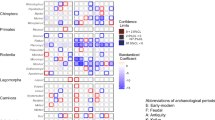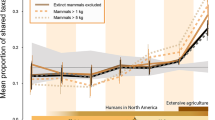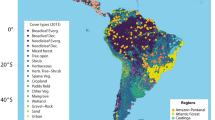Abstract
Communities have been shaped in numerous ways by past climatic change; this process continues today1. At the end of the Pleistocene epoch about 11,700 years ago, North American communities were substantially altered by the interplay of two events. The climate shifted from the cold, arid Last Glacial Maximum to the warm, mesic Holocene interglacial, causing many mammal species to shift their geographic distributions substantially2,3. Populations were further stressed as humans arrived on the continent4. The resulting megafaunal extinction event, in which 70 of the roughly 220 largest mammals in North America (32%) became extinct5, has received much attention. However, responses of small mammals to events at the end of the Pleistocene have been much less studied, despite the sensitivity of these animals to current and future environmental change. Here we examine community changes in small mammals in northern California during the last ‘natural’ global warming event at the Pleistocene–Holocene transition and show that even though no small mammals in the local community became extinct, species losses and gains, combined with changes in abundance, caused declines in both the evenness and richness of communities. Modern mammalian communities are thus depauperate not only as a result of megafaunal extinctions at the end of the Pleistocene but also because of diversity loss among small mammals. Our results suggest that across future landscapes there will be some unanticipated effects of global change on diversity: restructuring of small mammal communities, significant loss of richness, and perhaps the rising dominance of native ‘weedy’ species.
This is a preview of subscription content, access via your institution
Access options
Subscribe to this journal
Receive 51 print issues and online access
$199.00 per year
only $3.90 per issue
Buy this article
- Purchase on Springer Link
- Instant access to full article PDF
Prices may be subject to local taxes which are calculated during checkout


Similar content being viewed by others
Accession codes
Data deposits
Fossil specimens are deposited in the University of California Museum of Paleontology as localities V99822 and V99785. Modern specimens are deposited in the University of California Museum of Vertebrate Zoology under accession number 14590.
References
Blois, J. L. & Hadly, E. A. Mammalian response to Cenozoic climatic change. Annu. Rev. Earth Planet. Sci. 37, 181–208 (2009)
Graham, R. W. et al. Spatial response of mammals to Late Quaternary environmental fluctuations. Science 272, 1601–1606 (1996)
Lyons, S. A quantitative assessment of the range shifts of Pleistocene mammals. J. Mamm. 84, 385–402 (2003)
Goebel, T., Waters, M. R. & O’Rourke, D. The late Pleistocene dispersal of modern humans in the Americas. Science 319, 1497–1502 (2008)
Koch, P. L. & Barnosky, A. D. Late Quaternary extinctions: state of the debate. Annu. Rev. Ecol. Evol. Syst. 37, 215–250 (2006)
Naeem, S., Thompson, L., Lawler, S., Lawton, J. & Woodfin, R. Declining biodiversity can alter the performance of ecosystems. Nature 368, 734–737 (1994)
Grayson, D. K. in Late Quaternary Paleoecology in the Bonneville Basin Vol. 130 (ed. D. B. Madsen) 67–89 (Utah Geological Survey Bulletin, 2000)
Wittebolle, L. et al. Initial community evenness favours functionality under selective stress. Nature 458, 623–626 (2009)
Grayson, D. K. Mammalian responses to Middle Holocene climatic change in the Great Basin of the western United States. J. Biogeogr. 27, 181–192 (2000)
Graham, R. W. Late Wisconsin mammalian faunas and environmental gradients of the eastern United States. Paleobiology 2, 343–350 (1976)
Carrasco, M. A., Barnosky, A. D. & Graham, R. W. Quantifying the extent of North American mammal extinction relative to the pre-anthropogenic baseline. PLoS ONE 4, e8331 (2009)
Barnosky, A. D. in Biodiversity Response to Climate Change in the Middle Pleistocene. The Porcupine Cave Fauna from Colorado (ed. Barnosky, A. D.) 341–346 (Univ. of California Press, 2004)
Johnson, C. N. Interactions between mammals and ectomycorrhizal fungi. Trends Ecol. Evol. 11, 503–507 (1996)
Brown, J. H. & Heske, E. J. Control of a desert–grassland transition by a keystone rodent guild. Science 250, 1705–1707 (1990)
Liu, Z. et al. Transient simulation of last deglaciation with a new mechanism for Bølling–Allerød warming. Science 325, 310–314 (2009)
King, J. A. Biology of Peromyscus (American Society of Mammalogists Spec. Publ. No. 2, 1968)
Zwolak, R. & Foresman, K. Effects of a stand-replacing fire on small-mammal communities in montane forest. Can. J. Zool. 85, 815–822 (2007)
Myers, P., Lundrigan, B. L., Hoffman, S. M. G., Haraminac, A. P. & Seto, S. H. Climate-induced changes in the small mammal communities of the Northern Great Lakes Region. Glob. Change Biol. 15, 1434–1454 (2009)
Hadly, E. A., Spaeth, P. A. & Li, C. Niche conservatism above the species level. Proc. Natl Acad. Sci. USA 106, 19707–19714 (2009)
North Greenland Ice Core Project members. High-resolution record of Northern Hemisphere climate extending into the last interglacial period. Nature 421, 147–151 (2004)
Norrdahl, K. & Korpimäki, E. Effects of predator removal on vertebrate prey populations: birds of prey and small mammals. Oecologia 103, 241–248 (1995)
Heske, E., Brown, J. H. & Mistry, S. Long-term experimental study of a Chihuahuan Desert rodent community: 13 years of competition. Ecology 75, 438–445 (1994)
Gill, J. L., Williams, J. W., Jackson, S. T., Lininger, K. B. & Robinson, G. S. Pleistocene megafaunal collapse, novel plant communities, and enhanced fire regimes in North America. Science 326, 1100–1103 (2009)
Kitchen, A., Miyamoto, M. M. & Mulligan, C. J. A three-stage colonization model for the peopling of the Americas. PLoS One 3, e1596 (2008)
Buchanan, B., Collard, M. & Edinborough, K. Paleoindian demography and the extraterrestrial impact hypothesis. Proc. Natl Acad. Sci. USA 105, 11651–11654 (2008)
Treganza, A. E. An ethno-archaeological examination of Samwel Cave. Cave Studies 12, 1–29 (1964)
Arnold, J., Walsh, M. & Hollimon, S. The archaeology of California. J. Archaeol. Res. 12, 1–73 (2004)
Solomon, S. et al. Climate Change 2007: The Physical Science Basis. Contribution of Working Group I to the Fourth Assessment Report of the Intergovernmental Panel on Climate Change (Cambridge Univ. Press, 2007)
Barnosky, A. D. Heatstroke. Nature in an Age of Global Warming (Island Press, 2009)
Blois, J. L. Ecological Responses to Paleoclimatic Change: Insights from Mammalian Populations, Species, and Communities. PhD thesis, Stanford Univ. (2009)
Brown, T. A., Nelson, D. E., Vogel, J. S. & Southon, J. R. Improved collagen extraction by modified Longin method. Radiocarbon 30, 171–177 (1988)
Bronk Ramsay, C., Higham, T., Bowles, A. & Hedges, R. Improvements to the pretreatment of bone at Oxford. Radiocarbon 46, 155–163 (2004)
Bronk Ramsay, C. Radiocarbon calibration and analysis of stratigraphy: the OxCal program. Radiocarbon 37, 425–430 (1995)
Bronk Ramsay, C. Development of the radiocarbon calibration program OxCal. Radiocarbon 43, 355–363 (2001)
Reimer, P. et al. IntCal04 terrestrial radiocarbon age calibration, 0–26 cal kyr bp . Radiocarbon 46, 1029–1058 (2004)
Grayson, D. K. On the methodology of faunal analysis. Am. Antiq. 38, 432–439 (1973)
Grayson, D. K. Minimum numbers and sample size in vertebrate faunal analysis. Am. Antiq. 43, 53–65 (1978)
Hadly, E. A. Fidelity of terrestrial vertebrate fossils to a modern ecosystem. Palaeogeogr. Palaeoclimatol. Palaeoecol. 149, 389–409 (1999)
Hurlbert, S. H. The nonconcept of species diversity: a critique and alternative parameters. Ecology 52, 577–586 (1971)
Magurran, A. E. Measuring Biological Diversity (Blackwell Science, 2004)
Barron, J. A., Heusser, L., Herbert, T. & Lyle, M. High-resolution climatic evolution of coastal northern California during the past 16,000 years. Paleoceanography 18 1020 10.1029/2002PA000768 (2003)
R. Development Core Team. R: A Language and Environment for Statistical Computing (R Foundation for Statistical Computing, 2009)
Acknowledgements
We thank numerous field assistants, A. Barnosky, C. Li, and members of the J. Williams and E. Hadly laboratories for comments that improved the manuscript. The National Science Foundation (grants EAR-0545648 and EAR-0719429 to E.A.H.), California Energy Commission’s Public Interest Energy Research Environmental Area grant to J.L.B., and the Stanford University Vice Provost for Undergraduate Education supported this research. We are grateful for support from the US Forest Service.
Author information
Authors and Affiliations
Contributions
J.L.B. planned the project, excavated the deposit, identified specimens, analysed the data and wrote the paper. J.L.M. identified Microtus spp., performed radiocarbon dating and wrote the paper. E.A.H. planned the project, helped excavate the deposit and wrote the paper.
Corresponding author
Ethics declarations
Competing interests
The authors declare no competing financial interests.
Supplementary information
Supplementary Information
This file contains Supplementary Tables 1-5, Supplementary Figures 1-4 with legends, a Supplementary Discussion and References. (PDF 627 kb)
PowerPoint slides
Rights and permissions
About this article
Cite this article
Blois, J., McGuire, J. & Hadly, E. Small mammal diversity loss in response to late-Pleistocene climatic change. Nature 465, 771–774 (2010). https://doi.org/10.1038/nature09077
Received:
Accepted:
Published:
Issue Date:
DOI: https://doi.org/10.1038/nature09077
This article is cited by
-
Hunting and the Social Lives of Southern Africa’s First Farmers
Journal of Archaeological Research (2023)
-
Environmental and climate changes in the central Mediterranean between the end of the Late Pleistocene and the Early Holocene: Small and large mammals from the “Rock shelter” of Grotta del Romito (Papasidero, Cosenza, Italy)
Archaeological and Anthropological Sciences (2022)
-
Late quaternary biotic homogenization of North American mammalian faunas
Nature Communications (2022)
-
Genome-wide genetic variation coupled with demographic and ecological niche modeling of the dusky-footed woodrat (Neotoma fuscipes) reveal patterns of deep divergence and widespread Holocene expansion across northern California
Heredity (2021)
-
Landscape drivers of connectivity for a forest rodent in a coffee agroecosystem
Landscape Ecology (2020)
Comments
By submitting a comment you agree to abide by our Terms and Community Guidelines. If you find something abusive or that does not comply with our terms or guidelines please flag it as inappropriate.



